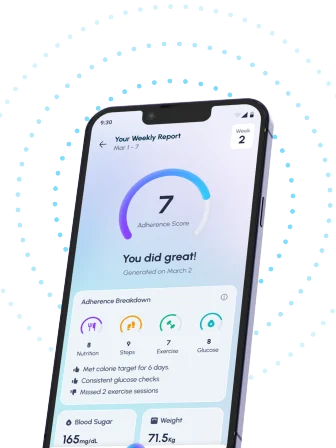Diabetes is a chronic condition that affects millions of people worldwide, and its impact goes beyond just blood sugar control. It can damage multiple organs, including the eyes. One common concern for people with diabetes is whether the condition can lead to glaucoma—a group of eye diseases that can damage the optic nerve and lead to vision loss.
So, does diabetes cause glaucoma? While diabetes doesn’t directly cause glaucoma, it can increase the risk of developing it. This is because diabetes, especially when poorly managed, can affect the blood vessels in the eyes, leading to damage that can result in glaucoma over time.
In this blog post, we’ll dive deep into understanding what glaucoma is, how diabetes can increase the risk of glaucoma, and what you can do to protect your eyes. Let’s explore the connection in detail and find out how you can take proactive steps to maintain healthy vision.
What is Glaucoma?
Before understanding how diabetes is linked to glaucoma, it’s important to know what glaucoma is and how it affects the eyes.
What Is Glaucoma?
Glaucoma refers to a group of eye diseases that cause damage to the optic nerve, which is responsible for sending visual information from the eye to the brain. When the optic nerve is damaged, it can lead to vision loss or even blindness if left untreated.
The most common form of glaucoma is open-angle glaucoma, which typically develops slowly and painlessly. It’s often referred to as the “silent thief of sight” because it has no noticeable symptoms in the early stages. By the time people notice vision changes, the damage to the optic nerve may already be significant.
What Causes Glaucoma?
The primary cause of glaucoma is increased pressure in the eye (known as intraocular pressure or IOP). This can occur when the fluid inside the eye, called aqueous humor, does not drain properly, leading to a buildup of pressure that damages the optic nerve.
However, glaucoma can also develop in people with normal eye pressure, and other factors such as genetics, age, and eye injury can increase the risk.
The Link Between Diabetes and Glaucoma
Diabetes, particularly when it is poorly controlled, can lead to a number of complications, and eye health is one of the most affected areas. But does diabetes directly cause glaucoma? While diabetes doesn’t directly cause glaucoma, there is a strong connection between the two conditions.
How Diabetes Increases the Risk of Glaucoma
People with diabetes are at a higher risk of developing several eye conditions, including diabetic retinopathy and glaucoma. Here’s how diabetes contributes to glaucoma:
- Damage to Blood Vessels: High blood sugar levels can damage the tiny blood vessels in the eyes, leading to poor blood flow and changes in the eye’s drainage system. This can lead to an increased risk of intraocular pressure (IOP) and, eventually, glaucoma.
- Diabetic Retinopathy: People with diabetes may develop diabetic retinopathy, a condition where high blood sugar causes damage to the retina. This condition can cause abnormal blood vessel growth and leakage of fluid, which can increase the risk of developing neovascular glaucoma—a type of glaucoma caused by new blood vessels forming in the eye.
- Increased Intraocular Pressure (IOP): People with diabetes may experience changes in the eye that increase intraocular pressure (IOP), which is the primary risk factor for glaucoma. Although not everyone with diabetes will develop glaucoma, studies show that the risk is significantly higher in those with uncontrolled blood sugar.
- Other Diabetes-Related Conditions: People with diabetes are also at higher risk for other eye conditions like cataracts and macular edema, which can worsen the risk of developing glaucoma.
What Is Neovascular Glaucoma?
Neovascular glaucoma is a specific type of glaucoma that is strongly associated with diabetic retinopathy. In this condition, the retina becomes damaged due to the high blood sugar levels, causing the formation of new, abnormal blood vessels. These new blood vessels can block the drainage angle of the eye, causing a dangerous increase in intraocular pressure.
How Does Glaucoma Affect People with Diabetes?
Diabetes-related glaucoma can be particularly dangerous because it may not cause noticeable symptoms until the disease has advanced. Here’s how glaucoma affects people with diabetes:
- Slow Vision Loss: Glaucoma generally causes vision loss in the peripheral vision, making it harder to see things out of the corner of the eyes. This can make daily tasks such as driving, reading, or navigating unfamiliar places difficult.
- Sudden Vision Loss: In more severe cases of glaucoma, patients may experience sudden vision loss or eye pain, especially if intraocular pressure rises rapidly. This is known as an acute angle-closure glaucoma attack, which is a medical emergency requiring immediate treatment.
- Risk of Blindness: If left untreated, glaucoma can eventually lead to total vision loss and blindness. Since diabetic retinopathy and glaucoma are both progressive conditions, they can compound each other’s effects, increasing the risk of severe vision impairment.
Managing Diabetes to Prevent Glaucoma
While it’s not possible to completely eliminate the risk of developing glaucoma if you have diabetes, there are several steps you can take to reduce your chances of developing eye problems. Proper diabetes management is key in protecting your eye health.
1. Control Blood Sugar Levels
Keeping your blood sugar levels in check is the most effective way to prevent diabetic eye diseases, including glaucoma. Consistently high blood sugar can damage blood vessels in the eyes, so blood sugar control is critical for eye health.
- Monitor your blood sugar regularly.
- Follow a balanced diet rich in whole grains, fruits, vegetables, and lean proteins.
- Exercise regularly to help control blood sugar levels.
- Work with your healthcare team to adjust medication and insulin therapy as needed.
2. Regular Eye Exams
One of the best ways to prevent vision loss from glaucoma is by catching it early. Regular eye exams are essential for people with diabetes, as they can help detect early signs of diabetic retinopathy and glaucoma. An eye doctor (optometrist or ophthalmologist) can perform specific tests to check for intraocular pressure and any signs of optic nerve damage.
- Dilated eye exams should be done at least once a year for people with diabetes.
- Comprehensive eye exams can detect early changes before symptoms appear.
3. Monitor Intraocular Pressure (IOP)
Your eye doctor may measure your intraocular pressure (IOP) to check for glaucoma. If you have diabetes, this is an important test to monitor since high IOP can damage the optic nerve over time.
4. Manage Other Health Conditions
People with diabetes are more likely to develop other conditions such as high blood pressure, high cholesterol, and obesity, which can worsen eye health. Managing these conditions can help reduce the risk of developing glaucoma and other eye problems.
- Keep your blood pressure under control through medication and lifestyle changes.
- Maintain a healthy weight to reduce strain on your eyes and overall health.
Treatment Options for Diabetic Glaucoma
If you’ve been diagnosed with glaucoma, there are several treatment options available to help manage the condition and preserve your vision.
1. Medications
- Eye drops are commonly prescribed to lower intraocular pressure (IOP). These drops may be beta-blockers, prostaglandin analogs, or alpha agonists, which work by reducing the production of fluid in the eye or increasing drainage.
- Oral medications may be prescribed if eye drops alone are not enough to control IOP.
2. Laser Treatment
Laser therapy can be used to improve fluid drainage in the eye and reduce intraocular pressure. This is often used when medications are ineffective.
3. Surgery
In more severe cases of glaucoma, surgery may be required to create a new drainage pathway for the eye fluid, reducing intraocular pressure. Surgical options include trabeculectomy and tube shunt surgery.
FAQ: Understanding Diabetes and Glaucoma
Q: Can diabetes directly cause glaucoma?
While diabetes doesn’t directly cause glaucoma, it increases the risk due to the damage it causes to blood vessels and other structures in the eye.
Q: How can I prevent glaucoma if I have diabetes?
The best way to prevent glaucoma is by keeping your blood sugar levels under control, maintaining regular eye exams, and managing other health conditions like high blood pressure and cholesterol.
Q: Are there symptoms of glaucoma in people with diabetes?
In the early stages, glaucoma may not show any symptoms. However, later stages can cause peripheral vision loss, eye pain, and, in severe cases, sudden vision loss.
Q: How often should I get an eye exam if I have diabetes?
It’s recommended that people with diabetes get a dilated eye exam at least once a year to monitor for any signs of diabetic retinopathy or glaucoma.
Conclusion: Protecting Your Eyes from Glaucoma
Diabetes does not directly cause glaucoma, but it significantly increases the risk due to damage to blood vessels in the eyes and other related complications. By managing your diabetes, staying on top of regular eye exams, and making healthy lifestyle choices, you can help protect your eyes and reduce your risk of developing glaucoma. Early detection and treatment are key to preventing vision loss, so take proactive steps to care for your eyes and overall health.



